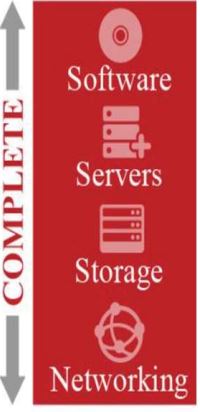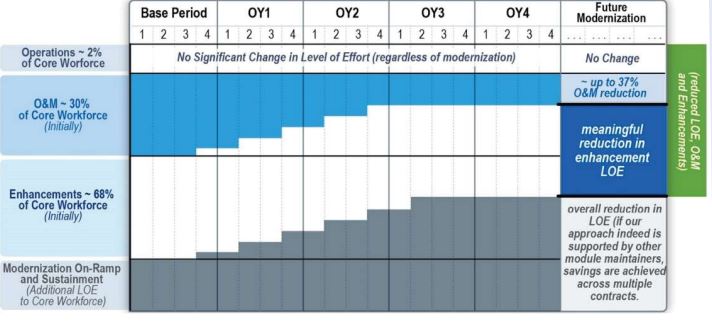
By Jeremy L.
Major companies and government agencies that have already moved into the Cloud are looking for ways to continue to modernize their infrastructure. As they do, they start looking at containers. ActioNet has been able to assist many of these organizations in accomplishing this correctly and securely. This article describes what containers in the cloud look like and how we can help you to continue your journey along the modernization path leveraging them.
What is Containerization?
Containerization is a category of operating system virtualization where applications or packages are run in secluded user spaces known as containers, utilizing one collective operating system. Fundamentally, a container is an entirely packaged and transferable computing setting. ActioNet uses containers in cloud computing as a methodology to allow users to utilize applications or software and their dependencies, including code, configuration files, libraries, binaries, and runtime, using isolated resource processes. The application’s code can be systematically packed up with dependencies and configurations. ActioNet views containers as a crucial part of modern DevSecOps, which stands for Development Security Operations. Containerized applications intrinsically have a security level because they can operate isolated procedures and run self-sufficiently from other containers.
Money
ActioNet’s Agile DevSecOps methodology focuses on cost savings for our customers. Containers are unique because they virtualize the operating system and can support several workloads on one operating system instance. One server can accommodate various containers since they have small sizes; in most cases, they are around tens of megabytes in size. The
resulting savings in maintenance and hardware expenses are among the
numerous benefits of containerization. Additionally, infrastructure is improved since it offers more dominance over the granular operations on resources. The container utilization in online facilities boosts storage with cloud computing data security, elasticity, and availability. Furthermore,
containers capture a trivial runtime setting for a package and all its components. Containers offer a standardized means of packaging up all the elements and operating them through the software development lifecycle (SDLC) on Linux, Windows, or Unix operating systems.

Reliability
In cloud computing, containers are used to generate blocks that assist in producing environmental reliability, version control, operational effectiveness, and developer productivity – all benefits of containerization. Due to this characteristic, our customers are guaranteed better reliability, quickness, and consistency irrespective of the disseminated platform utilizing containers. Containerization provides consistency in cloud storage since the container improves portability. Additionally, we use containerization to eradicate the technical and organizational abrasions to allow the software to move across the entire process sequence. Furthermore, containerization encapsulates the fundamental files of a software and application server and dependencies like an elementary unit, which can be disseminated to any resource. Therefore, each server’s manual structure is entirely avoided allowing our customers to broadcast a new characteristic.
Control
ActioNet also uses containerization to assist in producing version control in applications. In cloud computing, users can observe the application code’s current version and dependencies using containers or containerization. Additionally, the containers manage a manifest fi le. Users can easily track and hold the container’s edition, search for disparities between the container versions, and go back to previous versions when necessary.
Productivity
Developer Productivity is boosted when using containerization. Productivity augments because the containers deduct the conflicts and dependencies between the cross-service. The application’s component is segregated into distinct entities that support a different microservice. There is no issue with the synchronized dependencies and libraries for
every service since the containers are secluded from one another. Every service can be independently upgraded because they are not in close contact with each other.
Effectiveness
What ActioNet customers see in containerization is that it offers efficiency and effectiveness in operational activities. With containerization, our customers can attain more resources in cloud computing. More resources allow more concurrent users to utilize multiple applications simultaneously. However, the required disk space, central processing unit, and memory consumed by the container need to be specified. Although every container is an operating system procedure that runs on an application and related applications, the containers’ boot time is fast. Additionally, containerization allows users to quickly enter and exit the application and measure it up and down. Furthermore, the applications are set apart via the isolation process, a concept with no shared dependencies or inconsistencies.

Virtualization vs Containerization
Many ActioNet customers are currently utilizing virtualization and wish to move towards containerization. Virtualization and containerization are analogous in that they both support complete application isolation to be operational in various settings. Virtual machines are virtual environments that function as virtual computer systems with their memory, central processing unit, storage, and network interface, established on a physical hardware structure. The differences between containers and virtual machines lie in portability and size. Virtual machines are larger than containers, characteristically measured by the gigabyte and comprising their operation system, allowing them to undertake several resource-demanding operations simultaneously. In addition, the augmented resources available to virtual machines permit them to extract, divide, replicate, and imitate entire desktops, networks, operating systems,
servers, and databases.
On the other hand, containers are smaller than virtual machines and are characteristically measured by the megabyte and not packing anything larger than an application and its administration setting. Although virtual machines function effectively with monolithic and traditional information technology architecture, containers are designed to be compatible with emerging technology like DevOps, Continuous Integration/Continuous Delivery or Deployment (CI/CD), and clouds. However, unlike virtual machines, containers do not pack up in a copy of the operating system; rather, the container runtime engine is connected to the host structure’s operating system, becoming the channel through which all containers within the computing system share a similar operating system.
How Does This Scale for Future Growth?
ActioNet uses containerization and microservices as foundational facets of our software development practices as the concept behind both is alike. These practices fundamentally transform applications into assortments of smaller components or services that are scalable, easier to handle, portable, and efficient. Currently, communications are rapidly shifting to the cloud, where users can efficiently and rapidly create applications. Additionally, our customers can access cloud-based data and applications from any device connected to the internet, enabling the users to operate on the go and remotely. Moreover, Cloud Service Providers (CSPs) control the primary infrastructure, saving users the expense of servers and other tools, and offer automatic network backups for further reliability. Microservices, cloud computing, and containerization function together to bring application development and delivery to innovative extents that traditional settings and methodologies cannot bring.
But is it Secure?
ActioNet uses a “Security Everywhere” mentality in all our methodologies. Our teams understand that containerized applications function autonomously and operate as secluded processes. This seclusion means that each container has a different level of security. Complete isolation can stop any malevolent cryptograph from attacking the host system or impacting other containers. Although containerization provides resource efficiency, this characteristic opens the window for intrusion and security breaches through containers. Security threats towards the common operating system can affect all connected containers.
Additionally, a security breach in a container can potentially attack the host operating system. Containers are a vital concern for ActioNet’s Agile DevSecOps initiatives. The fundamental container security dimensions include image scanning, minimal base images, drift protection, and container image risk management. DevSecOps institutes security undertakings early in the systems development life cycle, rather than waiting to launch the product.
With ActioNet’s DevSecOps methodologies, security issues can be detected and solved during the application development procedure. Our DevSecOps processes prevent security weaknesses from reaching production, reducing the cost of mending faults after release. A cooperative culture assists in aligning DevOps eff orts with security enabling scalability. Automatic security guidelines are constructed into each development pipeline stage. Containerizations provide a conducive setting for DevSecOps collaboration. Since containers are unchangeable, they are swapped with newer models rather than being repaired during runtime, providing a form of environmental uniformity for developers, security, and operations. Containerization is possibly the most significant facilitator for DevSecOps enabling repeatable and rapid application development and deployment sequences with enhanced security.
Start Using Containers in Your Deployments
Our customers have been able to take advantage of all these benefits. Whether they are in the cloud, migrating to the cloud, or remaining in an on-premise virtualized environment, ActioNet has helped securely and effectively implement containers into their DevSecOps processes. The benefits are great and not only save time and money, but also help maintain reliability, control, productivity, and effectiveness. Our teams analyze the current environment and processes and give a plan forward that helps achieve mission success and give the added benefit of our “Security Everywhere” approach.
